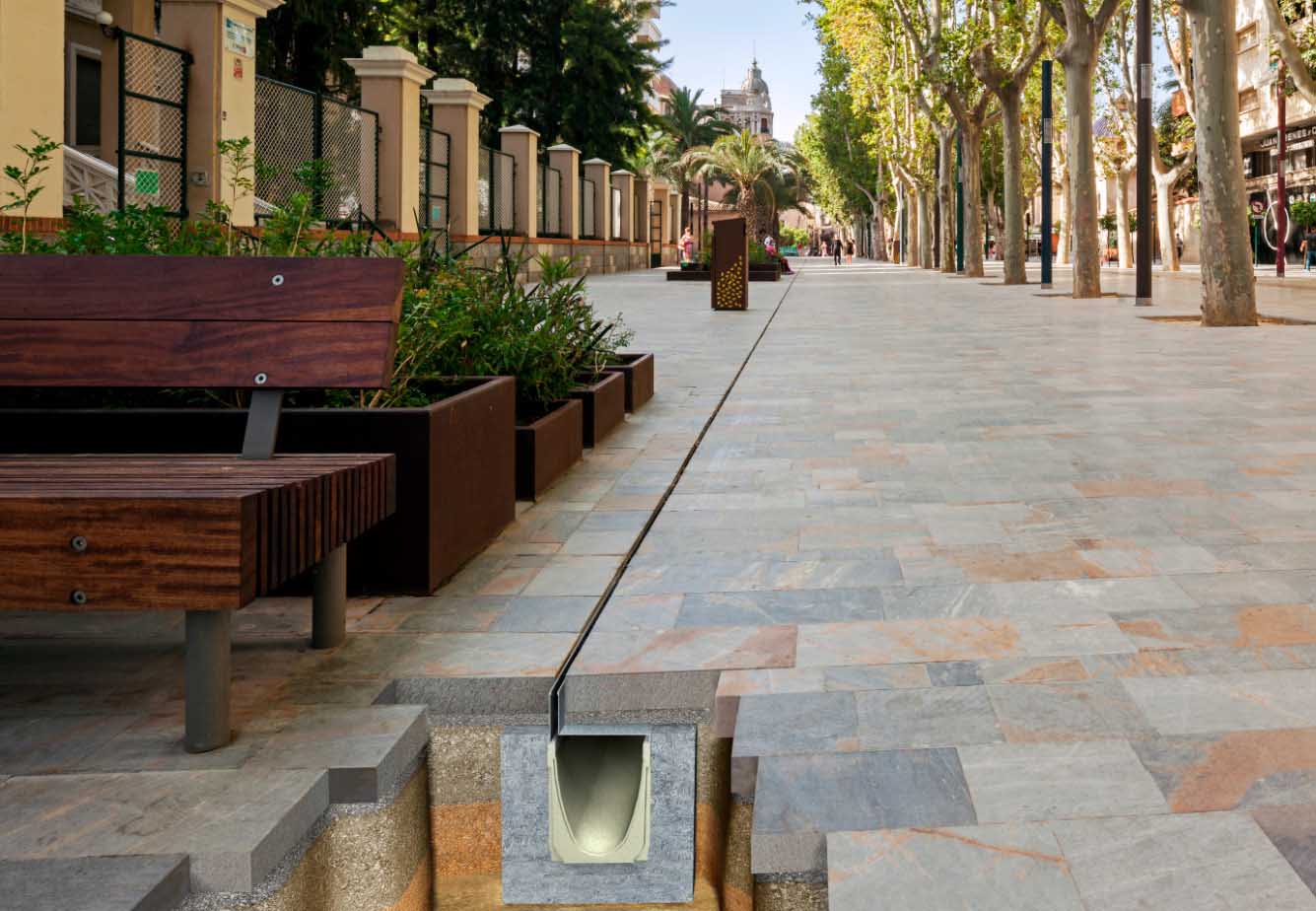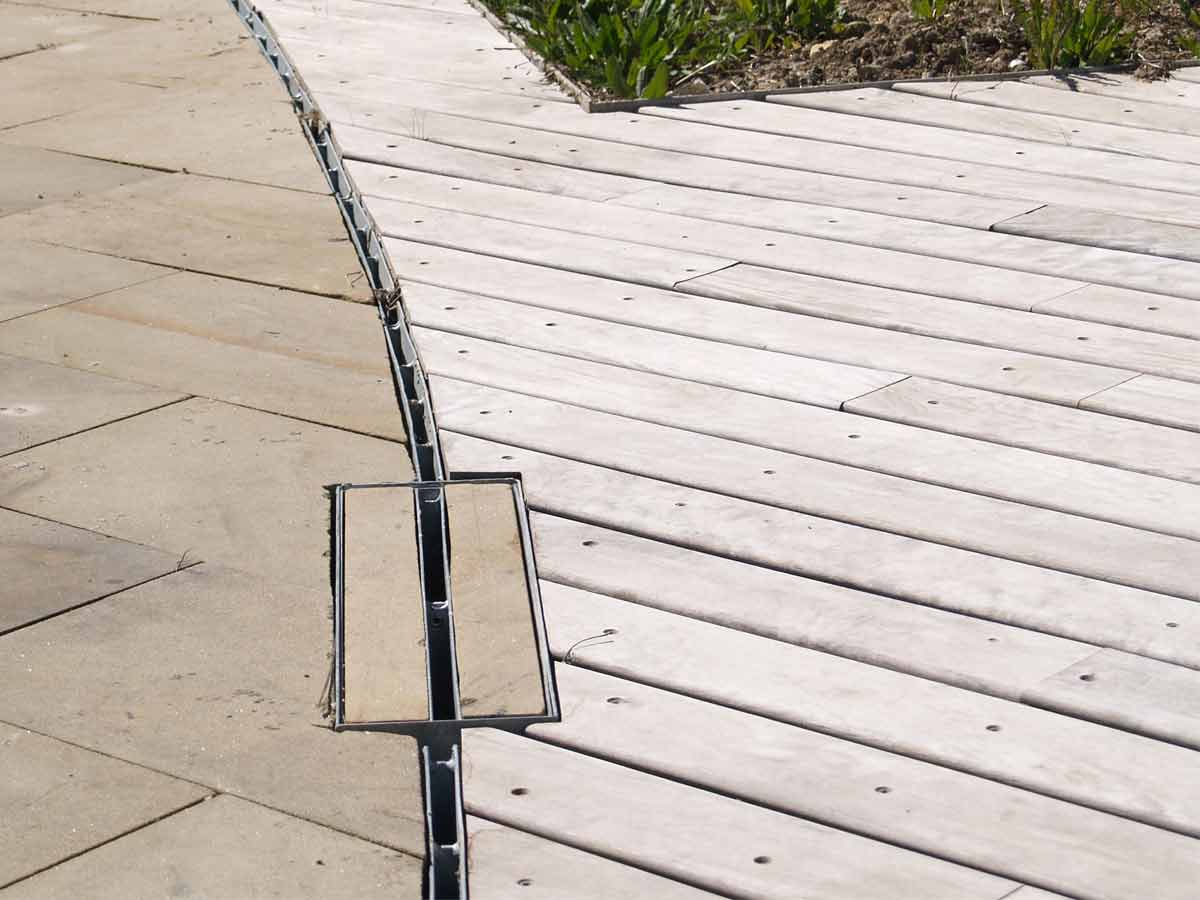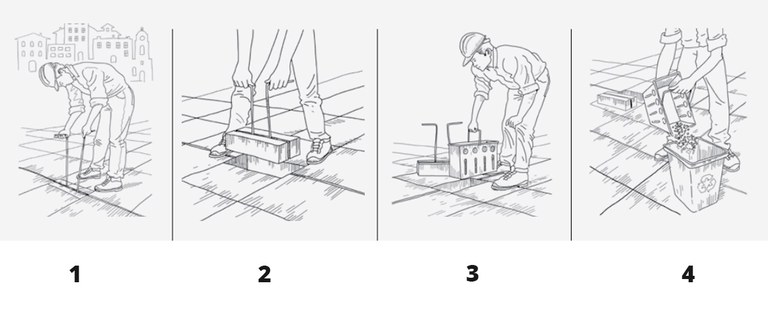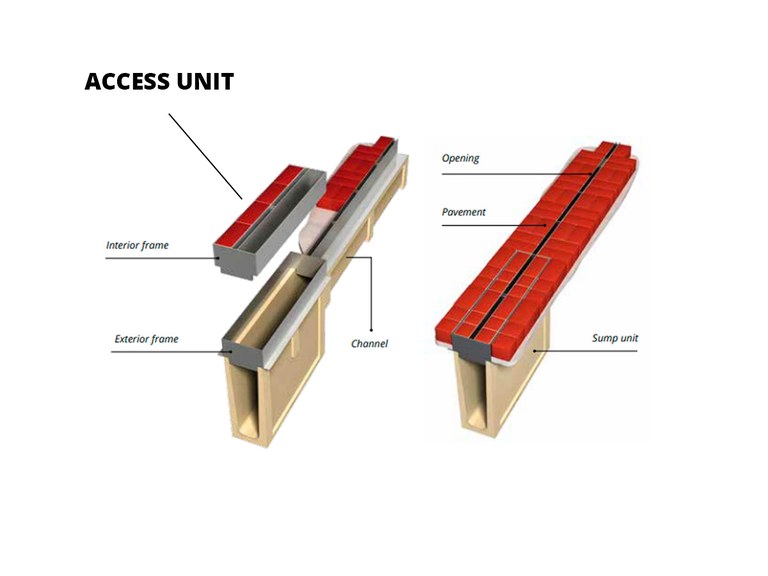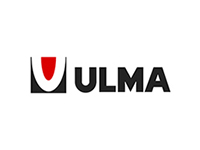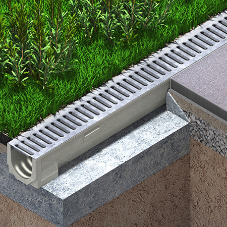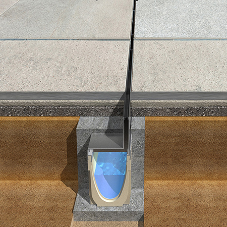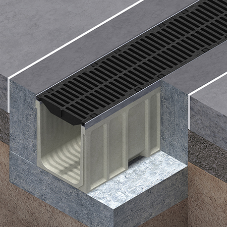Having a drainage system installed on your project it is an effective way of keeping areas free of water damage and dirt.
However, to keep drainage consistent, you need to properly maintain the grating of the drainage line.
In this article, ULMA give tips on how to clean a slot drain, the slot grating developed for areas where you need the drainage system to go unnoticed and you want it to be concealed.
The task may seem daunting and complex, but these tips for cleaning a slot drain can help.
How to clean a slot drain easily and effectively
Cleaning a slot drain is important to maintain its functionality and prevent clogs that can lead to water buildup and other issues.
The first thing to know is that you need to install clip-on manholes, or access units in the drainage line for maintenance and cleaning.
The manholes are made according to the same material characteristics and dimensions, allowing them to be taken off easily, in order to remove sediment, blockages or simply to carry out the necessary maintenance.
Here are the simple steps you need to follow for the correct removal of the access unit to be able to clean and maintain the slot drain.
Gather Supplies:
• Rubber gloves
• Protective eyewear
• Two metallic roads*
• Long-handled brush or scrubbing brush
• Bucket or container for debris
Safety First:
Before you start cleaning the slot drain, put on rubber gloves and protective eyewear to prevent any contact with potentially harmful substances or sharp objects.
1. You need to identify the access unit, it is very easy to recognise, because it has a square shape. Then, insert the two rods from the opening of the slot and turn.
2. Lift the acces unit with the bars and set aside.
3. Remove the bucket located in that grating.
4. Finally, you need to empty and clean the bucket before placing it again in its place.
Regular Maintenance:
To prevent future issues, consider performing regular maintenance on your slot drain. Cleaning it more frequently in high-traffic areas can help keep it in good working condition.
What is the difference between a Slot drain and a Channel drain?
Slot drain and channel drain are both types of linear drainage systems used to collect and convey surface water runoff in various applications, but they have some differences in their design and functionality.
Here's a brief overview of each:
Slot Drain:
• Slot drains are discreet and narrow linear drainage systems that consist of a long, narrow slot or channel with a built-in drainage pipe beneath it.
• The drain's surface usually has a grate or slotted cover to prevent debris from entering the drain while allowing water to flow through.
• Slot drains are typically used in areas where aesthetics and subtlety are important, as they can blend more seamlessly with the surrounding surfaces.
• They are commonly installed in places like pool decks, patios, pedestrian areas, and architectural landscapes.
Channel Drain:
• Channel drains are wider linear drainage systems with an open, U-shaped channel on the surface to collect water.
• These drains can handle higher flow rates compared to slot drains, making them suitable for areas with heavy rain or large amounts of water runoff.
• Channel drains are often used in more functional settings, such as driveways, parking lots, industrial areas, and roadways, where their primary purpose is efficient water drainage.
• They typically come with grates or covers to prevent debris from clogging the drain and are available in various materials, including plastic, concrete, or metal.
•The main differences between slot drains and channel drains lie in their appearance, flow capacity and applications. Slot drains are narrower, more discreet, and suitable for areas where aesthetics are essential, while channel drains are wider, more functional, and designed for areas with high water flow requirements. The choice between the two depends on the specific needs and priorities of the drainage project.
How much water can a slot drain handle?
What is its hydraulic capacity that a slot drain has? Its collection flow?
The water-handling capacity of a slot drain can vary depending on its size, design, and the specific manufacturer's specifications.
Slot drains are typically designed to handle moderate water flow rates and are best suited for areas with lower water volumes, such as pedestrian walkways, patios, pool decks, and landscaping applications.
The capacity of a slot drain is influenced by several factors, including the width and depth of the drain slot, the slope of the surrounding surface, and the materials used in the construction of the drain. Generally, slot drains are designed to handle surface water runoff from light to moderate rainfall.
ULMA has different models of slot drains and can be combined with several channel ranges, Domestic, Technical like the Multi V+ and the Civil range, when there is a need of higher hydraulic capacity it is possible to use the Civil F and the Civil S range.
The capacity of ULMA's slot drains it ranges from 150 cm2/ml to 240 cm2/ml, which is what the double-slot grating collects.
It's crucial to consult with the manufacturer or a drainage engineer to determine the appropriate type and size of the drainage system needed for a specific project, considering factors like the expected water flow, the slope of the surface, and the local rainfall patterns. Properly designed drainage systems are essential to ensure effective water management and prevent water-related issues like flooding and erosion.
What are the disadvantages of slot drain?
While slot drains offer several advantages, they also come with certain disadvantages that need to be considered when deciding on the appropriate drainage system for a specific application. Some of the disadvantages of slot drains include:
Limited water-handling capacity: Slot drains are generally not as effective as larger channel drains when it comes to handling high volumes of water. In areas with heavy rainfall or significant water runoff, a slot drain may become overwhelmed, but you have seen that in ULMA we have channels where the slot drain can fit and the hydraulic capacity can reach 240 cm2/ml.
Clogging potential: Slot drains can be more susceptible to clogging compared to some other drainage systems, especially if not properly maintained. The narrow opening of the slot can trap debris, sediment, leaves, and other materials, leading to reduced water flow or blockages that may require frequent cleaning. And here you have seen the way it should be done.
Installation complexity: Installing slot drains can be more complex and time-consuming than installing simpler channel drains. Proper installation requires precision to ensure a level surface and optimal water flow. In ULMA we offer clear instructions for installing this slot drain model, that will help to do the work in an easier way.
Maintenance challenges: Accessing and cleaning slot drains can be more challenging compared to some other drainage systems. Depending on the design and location, maintenance personnel may require specialized tools or equipment to clean and maintain the drain effectively.
Despite these disadvantages, slot drains can still be an excellent choice for specific applications where aesthetics and discreet drainage are priorities. It's essential to carefully assess the requirements of the project and consider the advantages and disadvantages of slot drains before making a decision. In some cases, a combination of slot drains and channel drains may be used to achieve the best overall drainage performance.
If you need to know more about this type of drainage solution you can find more information about ULMA's Slot drainage here.
How to Clean a Slot Drain
| T | (+44) 0754 2982 022 |
|---|---|
| 0793 221 5849 Tech Dept. | |
| E | mikelgarcia@ulmaarchitectural.com |
| W | Visit ULMA Architectural Solutions's website |
| Unit 20B Access 18, Avonmouth, Bristol, BS11 8HT |


